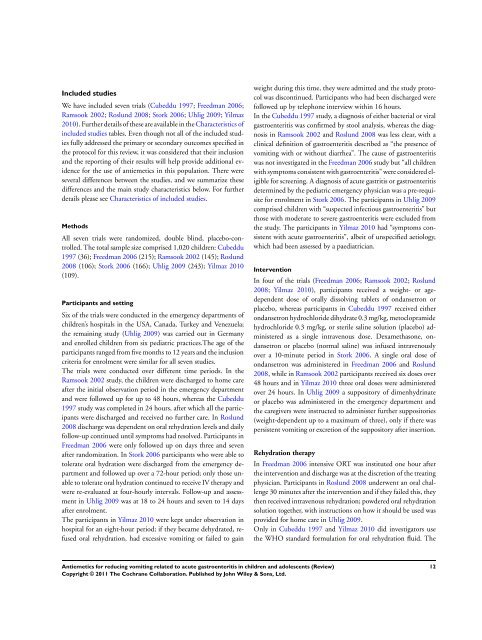Antiemetics for reducing vomiting related to acute ... - Update Software
Antiemetics for reducing vomiting related to acute ... - Update Software
Antiemetics for reducing vomiting related to acute ... - Update Software
You also want an ePaper? Increase the reach of your titles
YUMPU automatically turns print PDFs into web optimized ePapers that Google loves.
Included studies<br />
We have included seven trials (Cubeddu 1997; Freedman 2006;<br />
Ramsook 2002; Roslund 2008; S<strong>to</strong>rk 2006; Uhlig 2009; Yilmaz<br />
2010). Further details of these are available in the Characteristics of<br />
included studies tables. Even though not all of the included studies<br />
fully addressed the primary or secondary outcomes specified in<br />
the pro<strong>to</strong>col <strong>for</strong> this review, it was considered that their inclusion<br />
and the reporting of their results will help provide additional evidence<br />
<strong>for</strong> the use of antiemetics in this population. There were<br />
several differences between the studies, and we summarize these<br />
differences and the main study characteristics below. For further<br />
details please see Characteristics of included studies.<br />
Methods<br />
All seven trials were randomized, double blind, placebo-controlled.<br />
The <strong>to</strong>tal sample size comprised 1,020 children: Cubeddu<br />
1997 (36); Freedman 2006 (215); Ramsook 2002 (145); Roslund<br />
2008 (106); S<strong>to</strong>rk 2006 (166); Uhlig 2009 (243); Yilmaz 2010<br />
(109).<br />
Participants and setting<br />
Six of the trials were conducted in the emergency departments of<br />
children’s hospitals in the USA, Canada, Turkey and Venezuela;<br />
the remaining study (Uhlig 2009) was carried out in Germany<br />
and enrolled children from six pediatric practices.The age of the<br />
participants ranged from five months <strong>to</strong> 12 years and the inclusion<br />
criteria <strong>for</strong> enrolment were similar <strong>for</strong> all seven studies.<br />
The trials were conducted over different time periods. In the<br />
Ramsook 2002 study, the children were discharged <strong>to</strong> home care<br />
after the initial observation period in the emergency department<br />
and were followed up <strong>for</strong> up <strong>to</strong> 48 hours, whereas the Cubeddu<br />
1997 study was completed in 24 hours, after which all the participants<br />
were discharged and received no further care. In Roslund<br />
2008 discharge was dependent on oral rehydration levels and daily<br />
follow-up continued until symp<strong>to</strong>ms had resolved. Participants in<br />
Freedman 2006 were only followed up on days three and seven<br />
after randomization. In S<strong>to</strong>rk 2006 participants who were able <strong>to</strong><br />
<strong>to</strong>lerate oral hydration were discharged from the emergency department<br />
and followed up over a 72-hour period; only those unable<br />
<strong>to</strong> <strong>to</strong>lerate oral hydration continued <strong>to</strong> receive IV therapy and<br />
were re-evaluated at four-hourly intervals. Follow-up and assessment<br />
in Uhlig 2009 was at 18 <strong>to</strong> 24 hours and seven <strong>to</strong> 14 days<br />
after enrolment.<br />
The participants in Yilmaz 2010 were kept under observation in<br />
hospital <strong>for</strong> an eight-hour period; if they became dehydrated, refused<br />
oral rehydration, had excessive <strong>vomiting</strong> or failed <strong>to</strong> gain<br />
weight during this time, they were admitted and the study pro<strong>to</strong>col<br />
was discontinued. Participants who had been discharged were<br />
followed up by telephone interview within 16 hours.<br />
In the Cubeddu 1997 study, a diagnosis of either bacterial or viral<br />
gastroenteritis was confirmed by s<strong>to</strong>ol analysis, whereas the diagnosis<br />
in Ramsook 2002 and Roslund 2008 was less clear, with a<br />
clinical definition of gastroenteritis described as “the presence of<br />
<strong>vomiting</strong> with or without diarrhea”. The cause of gastroenteritis<br />
was not investigated in the Freedman 2006 study but “all children<br />
with symp<strong>to</strong>ms consistent with gastroenteritis” were considered eligible<br />
<strong>for</strong> screening. A diagnosis of <strong>acute</strong> gastritis or gastroenteritis<br />
determined by the pediatric emergency physician was a pre-requisite<br />
<strong>for</strong> enrolment in S<strong>to</strong>rk 2006. The participants in Uhlig 2009<br />
comprised children with “suspected infectious gastroenteritis” but<br />
those with moderate <strong>to</strong> severe gastroenteritis were excluded from<br />
the study. The participants in Yilmaz 2010 had “symp<strong>to</strong>ms consistent<br />
with <strong>acute</strong> gastroenteritis”, albeit of unspecified aetiology,<br />
which had been assessed by a paediatrician.<br />
Intervention<br />
In four of the trials (Freedman 2006; Ramsook 2002; Roslund<br />
2008; Yilmaz 2010), participants received a weight- or agedependent<br />
dose of orally dissolving tablets of ondansetron or<br />
placebo, whereas participants in Cubeddu 1997 received either<br />
ondansetron hydrochloride dihydrate 0.3 mg/kg, me<strong>to</strong>clopramide<br />
hydrochloride 0.3 mg/kg, or sterile saline solution (placebo) administered<br />
as a single intravenous dose. Dexamethasone, ondansetron<br />
or placebo (normal saline) was infused intravenously<br />
over a 10-minute period in S<strong>to</strong>rk 2006. A single oral dose of<br />
ondansetron was administered in Freedman 2006 and Roslund<br />
2008, while in Ramsook 2002 participants received six doses over<br />
48 hours and in Yilmaz 2010 three oral doses were administered<br />
over 24 hours. In Uhlig 2009 a supposi<strong>to</strong>ry of dimenhydrinate<br />
or placebo was administered in the emergency department and<br />
the caregivers were instructed <strong>to</strong> administer further supposi<strong>to</strong>ries<br />
(weight-dependent up <strong>to</strong> a maximum of three), only if there was<br />
persistent <strong>vomiting</strong> or excretion of the supposi<strong>to</strong>ry after insertion.<br />
Rehydration therapy<br />
<strong>Antiemetics</strong> <strong>for</strong> <strong>reducing</strong> <strong>vomiting</strong> <strong>related</strong> <strong>to</strong> <strong>acute</strong> gastroenteritis in children and adolescents (Review)<br />
Copyright © 2011 The Cochrane Collaboration. Published by John Wiley & Sons, Ltd.<br />
In Freedman 2006 intensive ORT was instituted one hour after<br />
the intervention and discharge was at the discretion of the treating<br />
physician. Participants in Roslund 2008 underwent an oral challenge<br />
30 minutes after the intervention and if they failed this, they<br />
then received intravenous rehydration; powdered oral rehydration<br />
solution <strong>to</strong>gether, with instructions on how it should be used was<br />
provided <strong>for</strong> home care in Uhlig 2009.<br />
Only in Cubeddu 1997 and Yilmaz 2010 did investiga<strong>to</strong>rs use<br />
the WHO standard <strong>for</strong>mulation <strong>for</strong> oral rehydration fluid. The<br />
12












